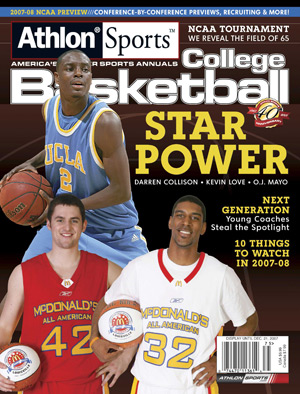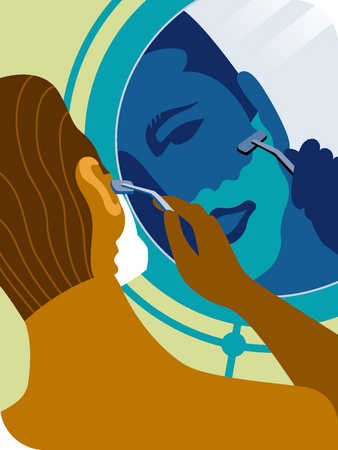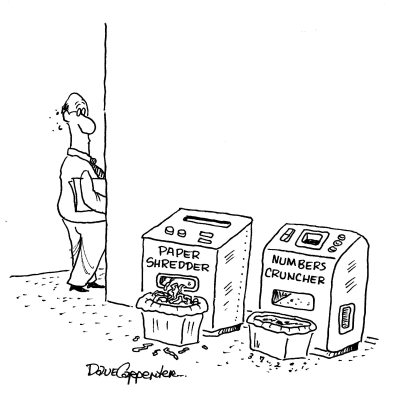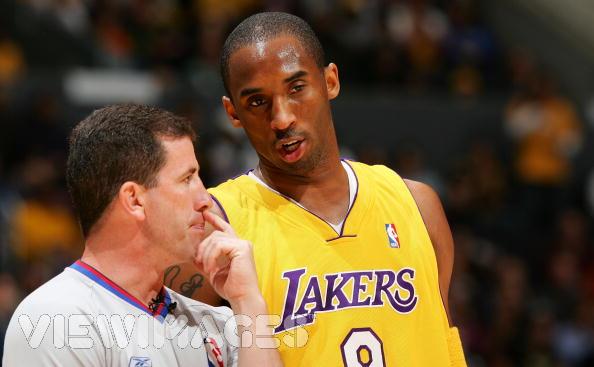Posted by rtmsf on September 12th, 2007
We’re heading into the middle of September already, literally thirty days until Midnight Madness, and the first batch of preseason mags are already proliferating on B&N shelves like West Virginians on crystal meth at a swap meet (no offense intended to the West Virginians not on crystal meth, of course). We know many of our readers are asking, “what’s a magazine?” To which we reply, “it’s what old people read while they’re on the toilet.” For our few readers here over 30 (present company excluded), we offer the first installment of our continuing series of reviews of the preseason magazines.
First in line: Athlon Sports.

I. Covers (5 pts) – are they cool? inclusive?
- 34 regional covers seems like overkill, but we suppose having a Minnesota/Iowa/Iowa St. cover matters to someone.
- Coolest Cover – for some reason, we particularly like the elated yet menacing look Patrick Beverly gives the camera on the Arkansas edition.
- Say What? Athlon’s UCLA/USC cover (above) features Kevin Love and OJ Mayo in their Burger Boy unis – was it really too much trouble to shoot them with their correct jerseys on?
- Total Points = 4
II. Ease of Use (5 pts) – how hard is it to find confs/teams?
- Conferences and teams are arranged alphabetically, allowing for quick navigation assuming you know your conference.
- Standard format otherwise – features & predictions; analysis of teams; recruiting, in that order.
- Total Points = 4
III. Roundup (10 pts) – every mag has one – tell us something new!
- 10 Things to Watch is ok, but we didn’t learn anything new (i.e., the Pac-10 is great, keep an eye on Love/Mayo/Gordon, etc.).
- Hoops Madness is a little better, mostly because of its lists of emerging stars (hot sophs to watch), top transfers and coaches on the hot seat. Also enjoyed learning that Dayton’s band has become the band by proxy for the Niagara Purple Aces (since NU doesn’t have one).
- Cool Stat Award. Memo to Adam Lonon (VMI) – shoot more! (31 starts, 26 FGs)
- Total Points = 5
IV. Features (15 pts) – give us some insightful and unique storylines.
- Next Generation is a decent article about the young brigade of coaches who have been successful so far (Donovan, Matta, JT3, Howland, etc.). It wasn’t unique, as we expect to see a lot of this in the rags this year.
- The Fix relates the story of the Tulane pointshaving scandal two decades ago. Although the article briefly mentions the Tim Donaghy story, it focuses primarily (and misguidedly) on the people involved in the scandal. What we needed to see here was an article about the existence of gambling among college athletes and efforts to prevent it. Big swing & miss here.
- The Scoop is three one-page interviews with Ronald Steele (Alabama), Bill Walker (Kansas St.) and Drew Neitzel (Michigan St.), none of which are very interesting.
- Total Points = 5
V. Predictions (20 pts) – how safe are their picks? do they take any chances? are they biased toward the big boys?
- Athlon uses the 65-team prediction model, eschewing the traditional Top 25 (they get pts for that). But Athlon goes waaaaaaaaay safe by predicting six of the elite eight the same as 2007 (Georgetown, Kansas, Memphis, UNC, Oregon, UCLA with Louisville and Tennessee added for good measure). UCLA defeats Carolina in the championship.
- Big Conference Bias. 15 of its Sweet 16 are from BCS conferences – highly doubtful and incredibly LAME! NCAA Bids – ACC (5), Big Ten (5), Big 12 (5), Big East (9), Pac-10 (7), SEC (6).
- Mid-Major Watch. Only Memphis from a mid-major conference (CUSA) into the Sweet 16. Mid-Major bids – 2 CAA (George Mason, VCU), 2 MVC (Bradley, S. Illinois), 1 A10 (Xavier), 1 Mountain West (BYU), 1 WAC (Nevada). We’ll bet anything Athlon’s editors choose that those six conferences will get more than eight bids next March.
- All-Americans. Athlon really likes Drew Neitzel for some reason. He joins Psycho T, Chris Lofton, Roy Hibbert and Darren Collison (?) on their first team. They took a big flier on putting oft-injured Ronald Steele on the third team.
- Boldest Prediction. It’s sad that we had to dig this deep to find it, but it’s probably their pick for Cornell to win the Ivy League over Penn & Princeton. The last time a team other than those two won the Ivy Championship was in 1988 with (guess who?) Cornell.
- Total Points = 10
VI. Conference Pages (5 pts) – as a primer for the conference, how much can we learn here?
- The major conferences get a predicted order of finish, a brief recruiting roundup, and three teams of all-conference selections plus a “superlatives” section, which is fairly weak compared to others we’ve seen (POY, DPOY, most underrated, newcomer).
- The mid-major and small conferences only get a predicted order of finish, one team of all-conference selections and an all-time NCAA Tourney stat for the conference (which is interesting).
- Total Points = 2.5
VII. Team Pages (20 pts) – how in-depth is the analysis? where does it come from? is it timely and insightful given this year’s squad or is it just a rundown of last year’s achievements?
- All major conference and projected mid-major NCAA Tournament teams get a full page of analysis, including evaluations of the frontcourt and backcourt as well as a team roster (w/ stats) and a team-oriented stat.
- Non-NCAA Tournament mid-majors and low majors get at most a half-page analysis and roster, but most only get a paragraph with a very brief synopsis.
- Clearly much of the analysis is based on what coach’s interviews, which results in analyses from “glass half full” perspective. We would have liked to have seen more contrarian viewpoints.
- The depth of analysis is solid if not spectacular for the major conference teams, but largely lacking for the others.
- Total Points = 14
VIII. Recruiting (5 pts) – we want to know who the top players are coming into college bball, where they’re going and who to watch for next year.
- Four pages of recruiting information, including the top 100 (Scout.com) of 2007, the next 200 players, and the top 20 by position. Solid raw data.
- It also includes the top 25 classes, but only as a list, with no additional details.
- The top 100 in the class of 2008, top 25 in 2009 and top 10 in 2010 are also listed.
- Total Points = 3
IX. Title IX Guilt (aka Chick Ball) (5 pts) – the less the better…
- Only two pages worth, and at the very back of the magazine.
- Total Points = 5
X. Intangibles (15 pts) – what’s good and bad about the magazine as a whole?
- In the past, Athlon’s mag hasn’t always looked as professional as some of the others. This is no longer the case. Its layout looks great, the photos and graphics are solid, and the writing has improved.
- Because it comes out so early, the advantage it gains in being one of the first published is mitigated by other temporal factors. Most notably, there are no schedules within the magazine – for that reason alone, Athlon cannot be your “go-to” preview issue during the season.
- Additionally, its early publish date means that it misses late summer news involving injuries, transfers and coaching changes. While they did get the Skip Prosser news in there, they did not, for example, consider how Andy Rautins’ knee injury will impact Syracuse.
- As a nontraditional magazine (i.e., not Street & Smith or TSN), Athlon should have taken more risks with their predictions – going all chalk won’t separate it from the pack.
- Total Points = 8
RTC Grade for Athlon = 60.5 pts
Basis: Athlon is on the lower side of quality with the preseason magazines, but they have gotten better, and there is some value in their analysis. Its best use (given its early arrival on the newstand) is simply to refamiliarize yourself with the names and faces of the upcoming season. We wouldn’t recognize purchasing it unless you simply cannot wait for the better ones to come out.
Grading Scale:
- 90-100 pts – exceptional quality in all areas – must buy and keep on-hand all season!
- 80-89 pts – very good quality mag – worthy of purchasing and reading cover-to-cover
- 70-79 pts – average, run of the mill magazine – some value in certain areas but weak in others – tough call as to whether to purchase it
- 60-69 pts – magazine on the weaker side, but may still have some positive attributes – probably not worth the money, though
- 0-59 pts – such a low quality magazine that it’s not worth any more than the five minutes you thumbed through it at the store
| 2007-08 season preview
| Tagged: acc, adam lonon, andy rautins, athlon, atlantic 10, big 10, big 12, big east, bill walker, bradley, byu, caa, chris lofton, cornell, cusa, darren collison, drew neitzel, george mason, georgetown, ivy league, kansas, kevin love, louisville, memphis, mid-majors, missouri valley, mountain west, nevada, niagara, oj mayo, oregon, pac-10, patrick beverly, pointshaving, preseason magazines, recruiting, ronald steele, roy hibbert, s. illinois, sec, skip prosser, syracuse, tennessee, title ix, tulane, tyler hansbrough, ucla, unc, usc, vcu, vmi, wac, xavier
Share this story
















































